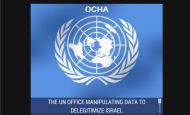Reuters and OCHA's Impeccable Timing
Last Thursday (April 7) NGO Monitor published a detailed report on OCHA, the UN humanitarian aid agency that abuses its mandate in working with high political NGOs and disseminates their factual and legal claims. A key finding was the media’s unquestioning repetition of data and statistics provided by OCHA, without verifying their accuracy.
Cue Reuters. The very day that we published, Reuters ran an article (“With demolitions, Israel tightens squeeze on West Bank Palestinians”) based primarily on allegations provided in an OCHA Humanitarian Bulletin ( “prepared by the United Nations Office for the Coordination of Humanitarian Affairs in collaboration with humanitarian partners” – meaning NGOs).
Soon after, the wire service’s Israel Bureau Chief tweeted an infographic produced by Reuters, exemplifying the way in which the media amplifies OCHA’s message. The graphic, which references OCHA as its source, actually contains two parts: a map of the West Bank with clustered data from January and February 2016 and a bar chart going back to 2009. The map is nearly identical to a map published in the aforementioned OCHA bulletin (page 5), with slight adjustments in colors and language, while the chart corresponds to the numbers and date range in a table in the same bulletin (page 4 – OCHA writes that it “began to systematically document the impact of demolitions in 2009.”).
Such collaboration is not uncommon, but rarely is the wholesale repackaging so blatant. Making this a prime example of what Mati Friedman identified as “an informal alliance….of activists and international staffers from the UN and the NGOs; the Western diplomatic corps, particularly in East Jerusalem; and foreign reporters” (“What the Media Gets Wrong About Israel,” The Atlantic, November 30, 2014).

